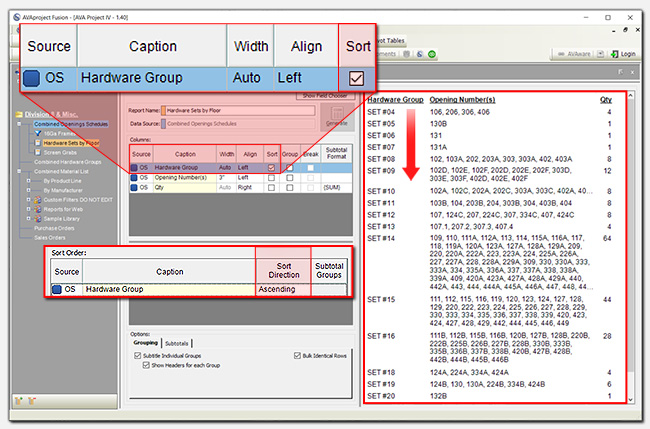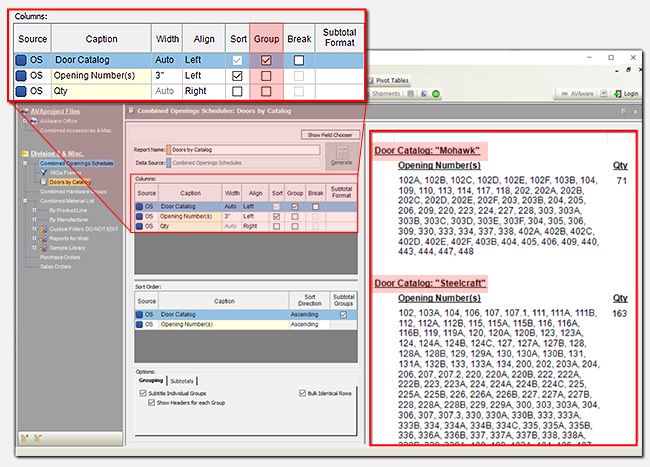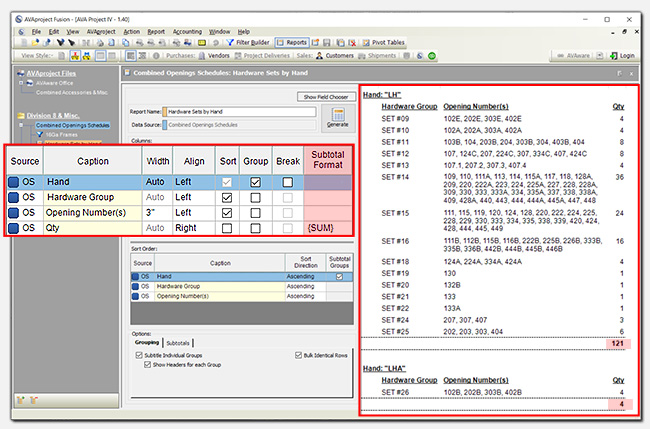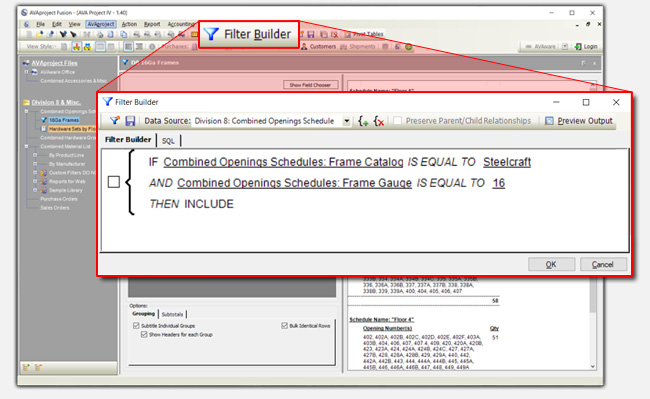|
The AVAproject Openings Schedule is a powerful and convenient means to detail and estimate architectural openings. It is the centerpiece of the AVAproject detailing and estimating system and provides a means to describe all aspects of the openings, from frame and doors to the hardware products associated with them.
One of the most compelling features of the openings schedule is its dynamic column layout features. Users can configure the schedule based on their preferences, to facilitate easier data entry, to match source documents, or to provide documents formatted per the preferences of individual architects. Column layouts can be changed "on the fly" and commonly used formats can be saved and reused across multiple projects.
Despite all this flexibility, invariably users will want even more. Individual needs and business processes are as varied and diverse as the products themselves, and nowhere is this more apparent than in the need for specialized and customizable reporting. Enter AVAproject Fusion - a comprehensive reporting tool that can provide an endless variety of reports, all designed by the users themselves to their exacting specifications.
The AVAproject Fusion reports are generally classified in two separate types. There are the classic "columnar" reports that can be sorted, grouped and sub-grouped by virtually any data field. They can further be totaled and sub-totaled in exactly the same way, providing countless reporting options that build upon the data contained in an AVAproject project file.
The other are the "pivot tables". This powerful table generation tool allows users to tabulate totals for any components of data (material, label, gage, size, etc.) to be counted against any other. Need to count how many frames or doors of a specific gage are required per manufacturer? The pivot table is the answer.
Creating Reports in AVAproject Fusion
All the data tables contained in an AVAproject file become available as data sources in Fusion. This article will focus specifically on the AVAproject Openings Schedules, the data from which is found in the section entitled 'Combined Openings Schedules'. This Fusion data table contains the contents of the all the openings schedules present in the original AVAproject file. Along with all their respective data, is an additional column, 'Schedule Name' which identifies from which schedule each line originated. By combining all the schedules into a single table (data source), Fusion enables users to create reports based on the contents of one or any combination of them.
Creating a report is extremely straightforward. A columnar report can be defined by simply selecting from the available fields (columns) to build a report as required. Each field corresponds to a schedule column and can be arranged as required.
Sorting
The report can be sorted by any or all of the selected fields; selecting the 'Sort' box next to a given field will cause its name to be added to the 'Sort Order' list at the bottom. In this box, the specific sort direction (ascending or descending) can be selected for each, along with the overall sort order for the entire report.

Clicking 'Generate' will result in a preview of the report to be generated per the design, containing all the data from the openings schedules, sorted as specified. The AVAproject Fusion design interface makes the creation and refinement of a report extremely convenient. Changes to the layout and options can be made and experimented with; the effects of which can be quickly previewed on the same screen.
Grouping
The contents of a report can be broken down into individual groups based on column data as easily as it can be sorted. Selecting the 'Group' option next to a given field will cause the report to grouped by that field.
In this example, the openings are separated by manufacturer.

Subtotals
The addition of subtotals for any given data column is every bit as straightforward as the sorting and grouping options. A 'Subtotal Format' selection is offered for each field and provides a variety of choices ranging from total counts and unique counts to sums, minimum and maximum values, averages, etc. Additional options are provided for details such as descriptions of totals, group descriptions, sub-titles and more.

Filters
Perhaps the most powerful reporting feature offered by Fusion is the 'Filter Builder'. To this point, the reports shown in this article have contained all the openings schedule data present in the source project. Through the use of filters, specific project data can be selected based on the data contained in any or all of the columns.
The filter builder pictured below illustrates an example of a simple data filter that selects openings whose frame are manufactured by "ABC" and consist of 16 gage construction. The filter itself is as straightforward to read as it is to create. The Fusion interface allows users to create filters using simple English phrasing.

The list of features and options offered in AVAproject Fusion is extensive and far beyond the scope of this article. Suffice it to say the variety of the reports that can be designed is endless and sure to accommodate the most demanding of business needs. Custom reports can be built that are as general or specific as necessary. Reports can be saved, copied and modified to adapt and grow as needs change.
For more information about AVAproject Fusion, or for assistance creating Fusion reports contact the AVAware Support Team.
|